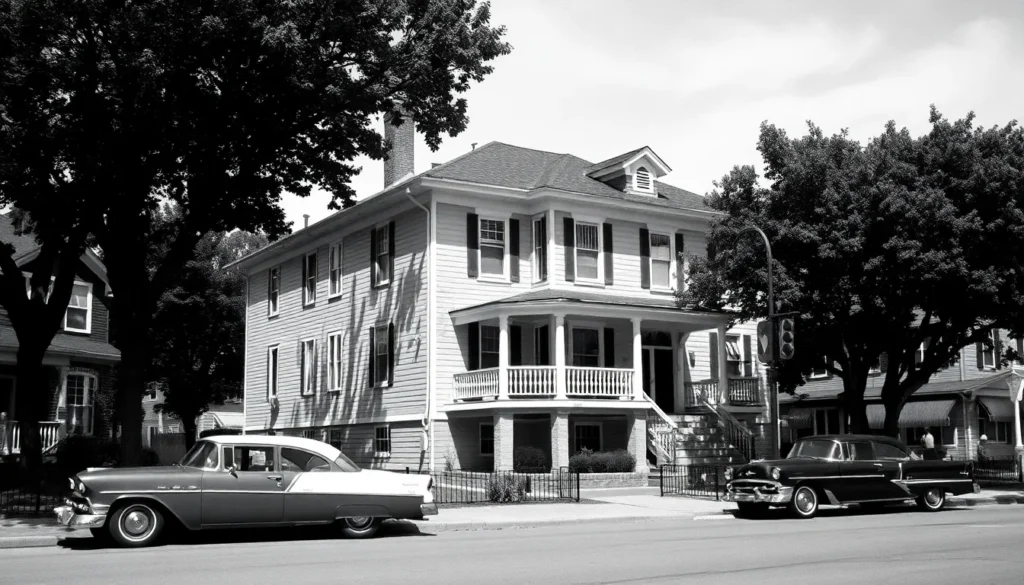Table of Contents
ToggleIn the realm of conspiracy theories and historical intrigue, few names stir the pot quite like James Earl Ray. Infamous for his role in the assassination of Martin Luther King Jr., Ray’s life has been the subject of speculation long after his passing. But wait—did he really shuffle off this mortal coil, or is he still plotting his next move from a secret lair?
Overview of James Earl Ray
James Earl Ray gained notoriety as the assassin of Martin Luther King Jr. on April 4, 1968. Ray’s background included a troubled childhood and numerous encounters with law enforcement. His criminal history consisted of burglary and armed robbery among other offenses.
After the assassination, Ray fled the scene and evaded capture for two months. His arrest occurred at London Heathrow Airport on June 8, 1968. Authorities charged him with King’s murder, and in March 1969, he pleaded guilty. He received a 99-year prison sentence, but that didn’t end the intrigue surrounding his case.
Many theories emerged after his incarceration, with some claiming Ray was a scapegoat. Various conspiracy theories suggested he may not have acted alone. Investigations revealed connections among organized crime and various government agencies, fueling speculation about the true story behind King’s assassination.
Ray spent the next years in prison, where he continued to protest his innocence. He made several appeals, seeking to overturn his conviction, but those efforts had little success. Ray’s health declined in the late 1990s, and he died of liver disease on April 23, 1998.
Rumors about his possible survival occasionally resurface. Some believe he could have evaded police and crafted new identities. Despite these theories, evidence substantiates that Ray died in 1998, casting doubt on any claims of his continued existence.
The Life of James Earl Ray

James Earl Ray’s life was marked by turmoil and infamy. His early experiences shaped much of his later behavior and decisions.
Early Years
James Earl Ray was born on March 10, 1928, in Alton, Illinois. His upbringing exhibited signs of instability, marked by poverty and family issues. Ray’s parents divorced when he was young, leading to further emotional challenges. Attending school proved difficult, resulting in frequent truancy from class. As a teenager, he dropped out of high school, which limited his future opportunities. By his late teens, he found himself moving from job to job with little direction, foreshadowing his problematic adult life.
Criminal Background
Ray’s criminal activities began in his youth, predominantly involving theft. His first arrest occurred at age 18, reflecting a budding pattern of unlawful behavior. Ray’s record subsequently expanded to include burglary and armed robbery. Over the years, incarceration became a frequent reality, resulting in multiple prison sentences. Each time, he emerged with a deeper criminal mindset, which ultimately contributed to his involvement in Martin Luther King Jr.’s assassination. By 1968, Ray had amassed a significant history of crime that positioned him as an unlikely candidate for notoriety.
The Assassination of Martin Luther King Jr.
The events surrounding Martin Luther King Jr.’s assassination on April 4, 1968, unfolded dramatically. King, a prominent civil rights leader, was in Memphis, Tennessee, to support striking sanitation workers. His commitment to nonviolent protest sparked hope but also anger among opponents. James Earl Ray, fueled by a history of criminal behavior, tracked King’s movements leading up to the event. On that fateful day, Ray fired a single shot from a boarding house across the street, fatally wounding King. Witnesses heard the gunfire and chaos ensued. Authorities quickly grew concerned about the implications of the attack, as it targeted a widely revered figure in the fight for equality.
The aftermath shocked the nation and prompted widespread civil unrest. Cities erupted in riots as communities mourned the loss of King, who had become a symbol of the struggle for civil rights. Ray’s swift arrest ignited debates about the motives behind the assassination. Conspiracy theories flourished, with speculation about potential co-conspirators including organized crime and government operatives. King’s assassination also spurred legislative changes, with lawmakers propelled to enact the Fair Housing Act in 1968. Public grief turned into a rallying cry, catalyzing further activism within the civil rights movement. The impact of this tragic event continues to resonate in discussions about race relations today.
James Earl Ray’s Capture and Trial
Ray’s capture and trial illustrate a turbulent chapter in American history. The swift sequence of events following Martin Luther King Jr.’s assassination ignited public interest.
Arrest and Charges
Ray’s arrest occurred on June 8, 1968, at London Heathrow Airport. U.S. authorities detained him while he attempted to flee to Brussels. Once back in the United States, he faced charges for King’s murder. Authorities also linked him to the infamous crime scene in Memphis, Tennessee. Evidence against him included ballistic tests that matched the rifle to the fatal shot. Despite his claims of innocence, the overwhelming circumstantial evidence positioned him as the primary suspect.
Sentencing and Imprisonment
In March 1969, Ray pleaded guilty to murder, receiving a 99-year prison sentence. His legal strategy aimed to avoid the death penalty, which loomed large over his case. During imprisonment, he experienced numerous challenges, including health issues and mental breakdowns. The prison system housed him for over 29 years, during which he continued to maintain innocence. Several legal appeals followed his conviction, yet all proved unsuccessful. Reports indicate that his health deteriorated significantly in the late 1990s. On April 23, 1998, he succumbed to liver disease while still incarcerated.
The Question: Is James Earl Ray Still Alive?
Questions about James Earl Ray’s status persist even years after his reported death. Speculation surrounding his life and fate remains alive, spurring ongoing debates.
Death Claims and Controversies
Death claims about James Earl Ray often arise from conspiracy theories suggesting he may have faked his demise. Some believe he could still be alive and orchestrating plans from a hidden location. Various sources contribute to this narrative, despite overwhelming evidence supporting his death. Notably, claims often lack substantial proof. Persistent rumors sometimes stem from long-standing mistrust in official accounts, fueling debates and interest. Critics highlight the impact of his actions, both historical and cultural, while conspiracy theorists emphasize gaps in public perception.
Official Confirmation of Death
James Earl Ray’s death received official confirmation on April 23, 1998. He succumbed to liver disease while serving a 99-year prison sentence. Medical records from the prison validate his death, leaving little room for doubt among most historians and experts. Multiple reports presented evidence supporting his demise, including autopsy results and witness accounts. Confirmation came from the Tennessee Department of Correction, which oversaw Ray’s incarceration. Even in the wake of rumors, the evidence remains compelling, with no credible indicators of survival. Speculation persists, but official documentation overwhelmingly confirms his passing.
The life of James Earl Ray remains a significant chapter in American history. While conspiracy theories about his survival persist, the evidence overwhelmingly supports the conclusion that he died in 1998. Medical records and autopsy results confirm his passing, dispelling the myths that suggest he might still be alive.
Ray’s actions had profound implications for the civil rights movement and the nation as a whole. Though discussions surrounding his motives and the circumstances of King’s assassination continue, the focus should remain on the legacy of Martin Luther King Jr. and the ongoing fight for justice and equality. The narrative of Ray’s life serves as a reminder of the complexities of human behavior and the impact of one’s choices.




